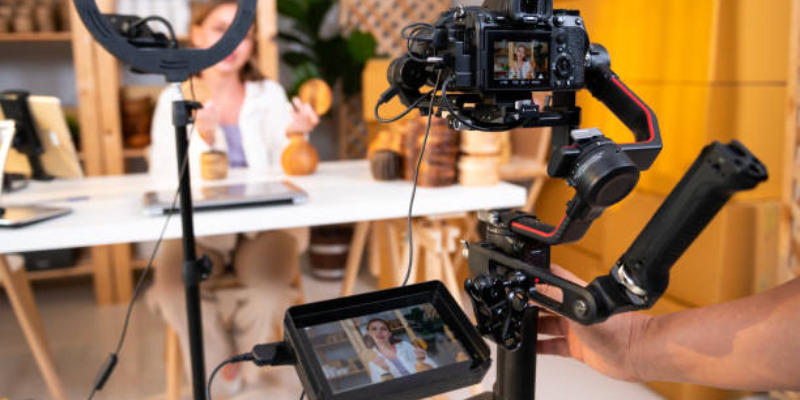How To Choose The Best Tech Gear For Live Streaming
If you are planning to start live streaming, kudos! You are on your way to becoming part of a large creator community that shares their interests with the rest of the world. First, let's address one crucial detail: you need to get the proper tech equipment before going live. Let's focus on choosing the appropriate tools for your streaming setup.
If you are planning to start live streaming, kudos! You are on your way to becoming part of a large creator community that shares their interests with the rest of the world. First, let's address one crucial detail: you need to get the proper tech equipment before going live. Let's focus on choosing the appropriate tools for your streaming setup.
Knowing Your Requirements
First and foremost, considering the content type you plan to stream will significantly affect your equipment selection. Will your concentration be on video games, music, cooking, or classroom lectures? Each content category has its criteria regarding audio and video standards and lighting.

For example, a gamer looking to stream his HD gameplay must spend money on a decent computer with good graphics. Then again, if you are set on broadcasting acoustic guitar sessions in your room, you will pay more for a microphone rather than top-of-the-range video equipment.
Cameras: The Eyes Of Your Stream
Now, let's discuss cameras. For most beginners, a webcam is easily the go-to option, and for some needs, it works decently. We all know that webcams are plug-and-play devices that are easy to use. While they provide reasonable-quality videos, they are also very affordable. However, if you decide to grow, consider purchasing a dedicated camera.
Image quality and control over settings such as ISO, aperture, shutter speed, etc., are the selling points of DSLRs and mirrorless cameras. Customization at this level allows you to create professional streams and cater specifically to your environment and audience. These cameras often come with better autofocus systems, which can be critical if you are a dynamic presenter.
Features such as resolution (aim for at least 1080p), frame rate (60fps is ideal for smooth motion), and connectivity options should all be considered. Some cameras have features that allow HDMI output directly to encoders or capture cards, which gives them the advantage of being more easily incorporated into your setup.
Audio Equipment: Sound Matters
Let us now turn to the audio aspect of the stream because nobody wants to watch a beautifully lit stream only to struggle to hear what is being said. A comprehensive audio setup consists of input devices, like microphones, and output devices if you want to play music or sound effects during the stream.
Dynamic microphones are suitable for noisy environments with a lot of background noise. On the other hand, condenser mics work better in quiet places because they are susceptible and can detect subtle sounds. USB microphones are easy to use and connect with most PCs, while XLR mics require more equipment and have better sound quality.
Don't forget about headphones as well! These are important as they eliminate the feedback loop when using a microphone and speakers and enable the accurate monitoring of audio levels. Look out for the closed-back versions, which are good at blocking outside noise.
Lighting Up Your Space
The proper lighting makes any space feel like a studio ready for recording. Natural light is excellent whenever available, but you can't always depend on windows since they can be erratic during particular weather or times of day. You would be better off with adjustable LED lights that enable you to regulate the brightness and colour temperature of the light.

Key lights shine on your face, fill lights soften shadows formed by key lights, and backlights increase separation to bring depth between you and the background. These three components are the fundamentals of three-point lighting – one of photography and videography's most used lighting techniques.
Consider getting softbox modifiers or diffusers that help spread light evenly throughout your scene rather than at a single point to reduce harsh reflections or glares. Don't forget that consistency matters, so try setting up your lights so they stay constant at different times of the day or night.
Software Solutions
After you've sorted out all the physical components, don't forget about the software's contribution towards improving your live streams. OBS Studio, Streamlabs OBS, and XSplit enable you to manage multiple scenes, overlays, transitions, and interactive elements like polls or donations stream as you want.
These platforms can also save the work needed to encode and broadcast through other services like YouTube Live, Twitch, and Facebook Gaming. To further customize your channel, try to learn basic editing with these applications. Engaging visuals combined with clear audio are the recipe for memorable viewing experiences, and these services help greatly.
Budget Considerations
Budget influences the selection of equipment that goes to your cart more than any other factor. Start small and build yourself up as your audience grows. The temptations of premium items are real, but must-haves versus nice-to-haves are identified at the beginning. This will enable a more intelligent allocation of funds.
For example, if voice clarity is a top priority, focus on getting a good-quality microphone before spending more money on a camera. Similarly, spending on tripods or stands rather than specialized mounts can save expenses.
Moreover, try to take advantage of deals and discounts available during holidays or events. Buying bundled items is, after all, more practical than purchasing each component individually.
Building Community Through Interaction
Building connections is vital for live streaming in addition to the technical elements. Responding to comments, asking questions, and inviting suggestions for future broadcasts with live Q&A sessions are ways to promote engagement.
Remember that feedback is meant for revisions and to help foster relationships with an audience. After all, isn't sharing stories, knowledge, or expertise the reason we began streaming in the first place?

How To Keep Up With Industry Changes
Due to the fast-paced development of technology, it is essential to follow where the new changes are coming from. One must sign up for newsletters, follow industry leaders on social media, attend webinars, and even participate in forums where other streamers share their tips and tricks.
Awareness of new devices being released in the market or new ways other people use already available tools can motivate changes to the user's setup. Also, adapting quickly to changes provides an edge against outdated peers.
Where To Get Help For Streaming Success
The equipment selection for streaming should be carefully selected, considering the user's wants, needs, budget, intended scenarios, and future goals. Complying with the abovementioned tips will enable you to tell enthralling and captivating stories on the world stage.